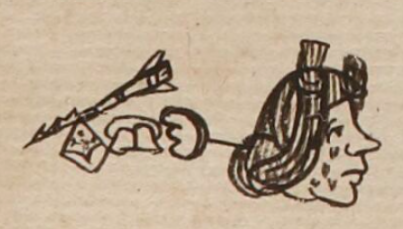Icnocihuatl (Verg9r)
This black-line drawing of the compound glyph for the personal name or status of Icnocihuatl (“Widow,” attested here as a woman’s name) shows the head of a woman (cihuatl) in profile, looking toward the viewer's right. She has tears on her cheeks (drawn more in a European style than the tears found in early manuscripts). These tears are a semantic indicator that the woman is a widow (icnocihuatl) and therefore sad or humble (icno-, a built-in adjective here). The remaining four elements of this compound probably attempt to provide phonetic values for some of the syllables. From right to left, these are: lips (tentli), teeth (tlantli), a maize cob (cintli) or centli), and finally an arrow (mitl). Of these, the "ci" of cintli could provide the phonetic start to cihuatl. The roles of the other elements remain to be deciphered.
Stephanie Wood
Perhaps this compound glyph is actually providing a name for this widow--not just covering her marital status--that does not appear in the gloss.
Stephanie Wood
franca ycnoçihuatl
Francisca Icnocihuatl
Stephanie Wood
1539
Jeff Haskett-Wood
viudas, widows, sad, triste, humble, humilde, flechas, dientes, labios, mazorcas, mujeres

cihua(tl), woman, https://nahuatl.wired-humanities.org/content/cihuatl
icnocihua(tl), widow, https://nahuatl.wired-humanities.org/content/icnocihuatl
Viuda
Stephanie Wood
Codex Vergara, folio 9r, https://gallica.bnf.fr/ark:/12148/btv1b84528032/f25.item.zoom
The non-commercial reuse of images from the Bibliothèque nationale de France is free as long as the user is in compliance with the legislation in force and provides the citation: “Source gallica.bnf.fr / Bibliothèque nationale de France” or “Source gallica.bnf.fr / BnF.” We would also appreciate a citation to the Visual Lexicon of Aztec Hieroglyphs, https://aztecglyphs.wired-humanities.org/.




